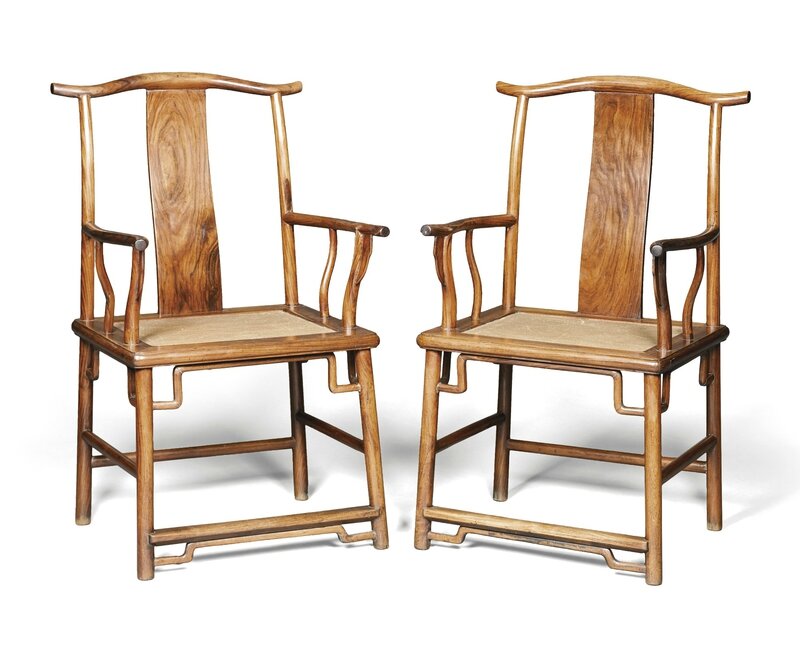A pair of huanghuali 'Official's Hat" yokeback armchairs (guanmaoyi), 17th century
A pair of huanghuali 'Official's Hat" yokeback armchairs (guanmaoyi), 17th century. Photo courtesy Sotheby's
each with a scrolled crest rail above a gently curved backsplat, with out-scrolled arms supported by S-form stiles mortise and tenoned to the seat frame, the legs joined by footrail and back stretchers. Quantité: 2 - 58 by 48 by 104cm., 22 7/8 by 18 7/8 by 41in. Estimate 80,000 — 120,000 GBP. Unsold
Thence by descent.
Huanghuali yoke-back armchairs of this type embody a timelessness in their striking linearity and harmony of form, and were associated with status and authority of the elite gentry in Chinese society. Known as guanmaoyi, or ‘official hat-shaped chairs’, due to their resemblance to the winged hat of Ming officials, they were further categorised into two types: those with protruding crest rails,sichutonuguanmaoyi, and those without, nanguanmaoyi. The elegance of these chairs lies in the vertical lines which extend outwards slightly as they rise from the seat to lighten the overall effect.
Craig Clunas in Chinese Furniture, London, 1988, p. 20, describes armchairs of this type as being made in pairs, suggesting Chinese room arrangements aimed for symmetry. He further notes that Ming and Qing period literature illustrations characteristically show them used at dinner tables, in reception halls for guests and at the writing table in the scholar’s studio, and illustrates a woodblock print of the 1616 edition of The Golden Lotus(Jing Ping Mei), p. 22, fig. 8. This scene shows the main male figure and his principal wife seated on guanmaoyiwhile dining with his secondary wives and concubines who are seated on stools. For a general discussion on the basic model and decorative vocabulary of these armchairs see Curtis Evarts, ‘From Ornate to Unadorned’, Journal of the Chinese Classical Furniture Society, Spring 1993, pp 24-33.
Huanghuali armchairs of this type can be found in a number of museum and private collections; a closely related example, but with a wood seat, from the collection of Chen Mengjia, is illustrated in Wang Shixiang, Classic Chinese Furniture, Hong Kong, 1986, pl. 45; and another is included in George N. Kates, Chinese Household Furniture, New York, 1948, pl. 79. Compare similar chairs, but lacking the posts under the arm rests, such as one made from rosewood, from the Qing Court collection and still in Beijing, published in The Complete Collection of Treasures of the Palace Museum. Furniture of the Ming and Qing Dynasties (I), Hong Kong, 2002, pl. 27; and a hardwood example in the Nanjing Museum, included in Wang Shixiang, Connoisseurship of Chinese Furniture. Ming and Early Qing Dynasties, Hong Kong, 1990, pl. A71.
Sotheby's. Fine Chinese Ceramics & Works of Art. London | 06 nov. 2013 - www.sothebys.com

/https%3A%2F%2Fprofilepics.canalblog.com%2Fprofilepics%2F1%2F0%2F100183.jpg)
/https%3A%2F%2Fstorage.canalblog.com%2F03%2F02%2F119589%2F96711876_o.jpg)
/https%3A%2F%2Fstorage.canalblog.com%2F11%2F31%2F119589%2F94773502_o.jpg)
/https%3A%2F%2Fstorage.canalblog.com%2F20%2F83%2F119589%2F94772815_o.jpg)
/https%3A%2F%2Fstorage.canalblog.com%2F26%2F72%2F119589%2F75604929_o.jpg)
/https%3A%2F%2Fstorage.canalblog.com%2F59%2F60%2F119589%2F26458628_o.jpg)



/http%3A%2F%2Fstorage.canalblog.com%2F32%2F99%2F119589%2F129836631_o.jpg)
/http%3A%2F%2Fstorage.canalblog.com%2F46%2F82%2F119589%2F129704536_o.jpg)
/http%3A%2F%2Fstorage.canalblog.com%2F49%2F48%2F119589%2F129680938_o.jpg)
/http%3A%2F%2Fstorage.canalblog.com%2F64%2F83%2F119589%2F129635530_o.jpg)